
For as long as Africans have engaged in revolutionary struggle within the present-day United States, they have always sought to document and report on their efforts to resist. What was very common and was known as “movement journalism” has been central to how Black people in the US have historically covered their challenges to their oppressors. Revolutionary publications have frequently questioned what sort of politics to express and what audience to target. In a small editorial published in November 1966 by friends of the Student Nonviolent Coordinating Committee’s (SNCC) in The Movement newspaper, the editors of the publication addressed this question. The editorial, appropriately entitled “What is a revolutionary newspaper?,” succinctly describes the criteria for what a publication needs to express as a political history document, as well as what a newspaper and its reporting must do to actually serve the people. They maintain that the contents of the paper need to be immediately useful to the people’s organizing struggles, that they need to have clear tactics and rationale for their politics, and that they need to offer tangible tasks for readers to implement in their organizing. A revolutionary publication must also accurately report what happened in a particular event and challenge the disinformation of the mainstream press. A revolutionary newspaper needs to connect local struggles and support coalition-building within the overall Black Liberation Movement, while also linking domestic and international peoples’ struggles as acts of liberation and anti-colonialism.
The underground press was omnipresent in the movement during this period. Unlike publications of today, the physical production and distribution of a newspaper took place in one specific community and offered a more intimate relationship with residents. Beyond simply being a “community newspaper,” the underground press was positioned diametrically opposed to mainstream news. Being “underground,” the goals of these sorts of publications were to offer a distinct perspective critical of state activity and offer support to political organizing in one’s local area. You could speak directly with a writer because they lived near you. Additionally, many Black political organizations asked their members to deliver papers and help politicize folks during their routes. These papers were vehicles for connecting communities with broader international issues framed around their local crises. A journalist from the Atlanta area could, for example, explain the significance of the Cuban revolution to Black people in that specific city, pointing towards possible opportunities to build solidarity. The concept of a movement newspaper opened new opportunities for political radicalization and, more importantly, for accountability within the journalism they consumed. Knowing personally who wrote, edited, published, and distributed the news in your neighborhood offered a different level of accountability for movement journalism. You could directly engage in a person-to-person relationship with the people producing your news. This lent itself to more opportunities to vocalize criticism of coverage and offer advice on how the publication could do better.
The editors of The Movement were deeply invested in trying to understand how a newspaper, whether theirs or another organization’s, needed to speak about the suffering and depravation of those who want to “loot from this unjust system.” They were also very clear that the language of a revolutionary newspaper needed to define terminology that was being used in political organizing. Lastly, and most importantly, the 1966 editorial called for political organizations to be constructively criticized but also supported in material ways. The purpose of a revolutionary paper appears to be a space for continual dialogue, to begin conversations within the movement that would strengthen their political alliances. While written over fifty years ago, The Movement’s editorial offers us some keen insights into what a publication ought to do in service of radical, African-led political activity in this current moment.
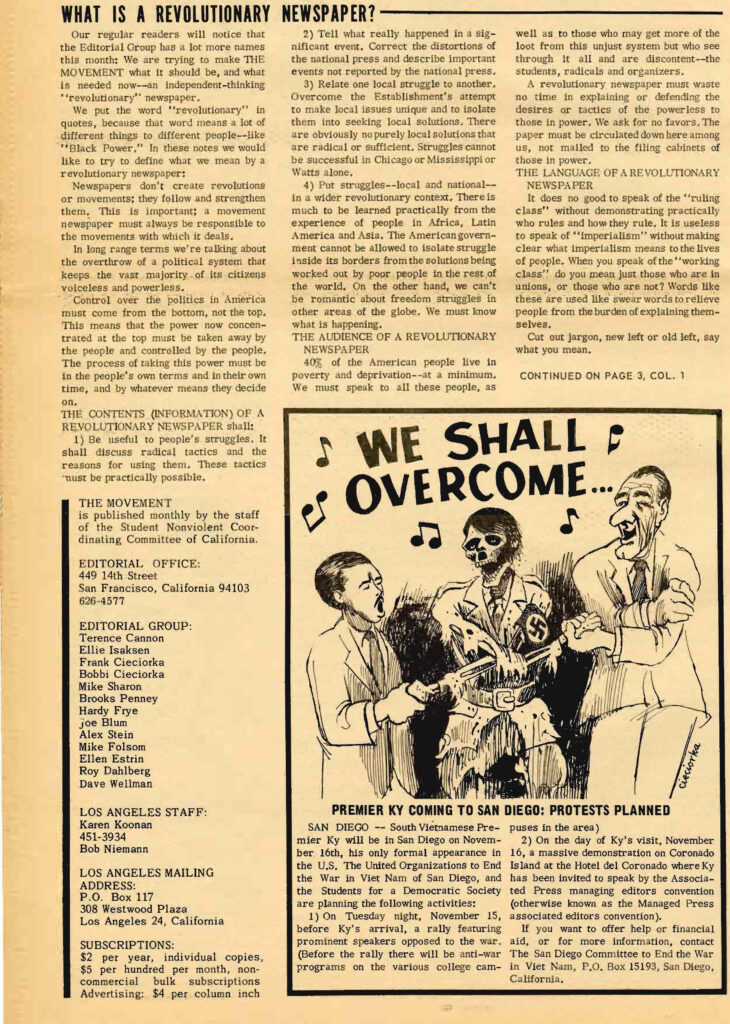
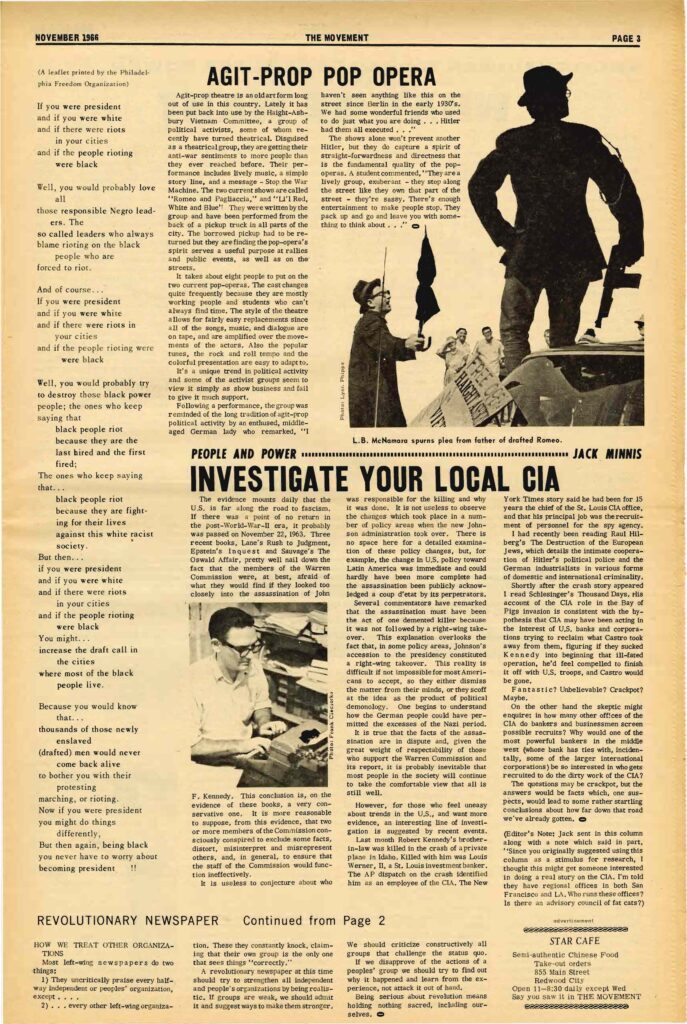
Several decades later, Dr. Hemant Shah in a 1996 unrelated article for the academic journal Communication Theory, drew similar conclusions in his assessment of what rigorous movement journalism needs to entail. He coined the term “emancipatory journalism” as a way to broadly identify the type of journalism that political organizations need to employ if they seek to adequately serve the movement. Dr. Jared Ball from Morgan State University in Baltimore identifies the core tenets of emancipatory journalism in a blog post on the subject:
A) presupposes that inequality and oppression exist and that there are (neo)colonies and colonized populations requiring a form of journalism that is;
B) bottom-up. Central to EJ’s concept of good journalism are the perspectives of those most oppressed, those of members of the communities themselves, as opposed to government or business officials and elites and;
C) argues that notions of “objectivity” must be critiqued if not entirely discarded in favor of clearly identified, studied, researched perspectives that advocate radical re-ordering of societies.
Dr. Shah’s concept emerges out of a similar tradition to the one that The Movement’s editors discussed in 1966. Dr. Shah is also interested in asking us to be self-critical about the role journalists must play in radical, grassroots political organizing. Dr. Shah notes in particular that “Journalists take on the role of professional movement intellectuals, providing energy for social movements and helping create awareness about the need for action.” For SNCC and Dr. Shah, the relationship of the press that should exist with radical organizations is one that needs to not be centered around evaluating how just or unjust a particular event or situation is; rather, journalists that seek to engage in building a revolutionary publication should be explicit in their commitment of transformative and radical objectives of the organizations for which are spearheading a particular political movement.
Freedom Archives houses a substantive collection of publications that align broadly with SNCC and Dr. Shah’s frameworks of revolutionary publication and emancipatory journalism, respectively. Broadly, these types of publications help highlight through their reporting how attempts of state counterinsurgency can shift the public perception of the news, along with how formations attempt to sustain their organizing in response to state intervention. For example, The Black Panther Black Community News Service, the Black Panther Party’s (BPP) newspaper, helps us today understand how the party dealt with various political conflicts. From the BPP split in April 1971 from the Oakland perspective to covering the development of the party’s programs all across the nation, The Black Panther exemplified a commitment to the movement and an investment in informing the public about their political activity. This same can be seen even in the Harlem chapter’s Right On! Black Community News Service. At the split announcement, the first issue of Right On! opened with an editorial calling for the dissolution of the BPP’s central committee. The Black Panther and Right On! contained lengthy reflections from Huey P. Newton and Eldridge Cleaver, respectively, as they each contextualized how they saw their strategic preferences impacting the BPP. The party split was less about geographical differences and instead more about the ideological challenges the party faced. How the party should address engaging in clandestine versus above-ground activities and how they should support the movement’s political prisoners were much more pertinent questions than the personalities of Newton and Cleaver. The very important disagreements between the party split were greater than the individuals themselves involved and had implications for how the party shifted after this moment.
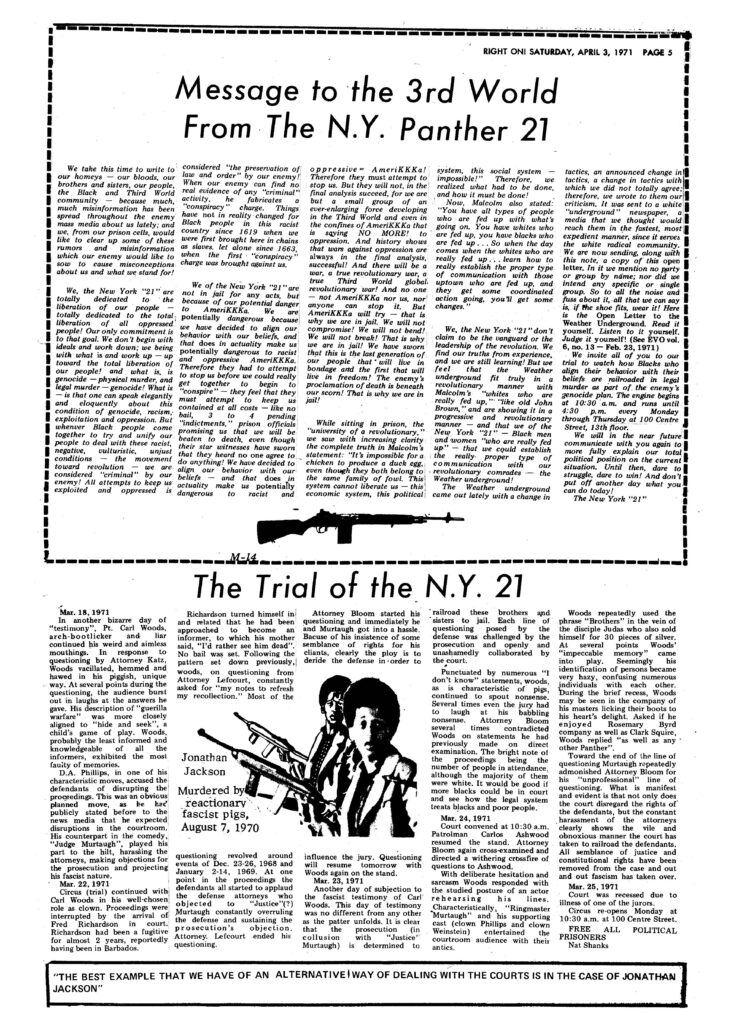
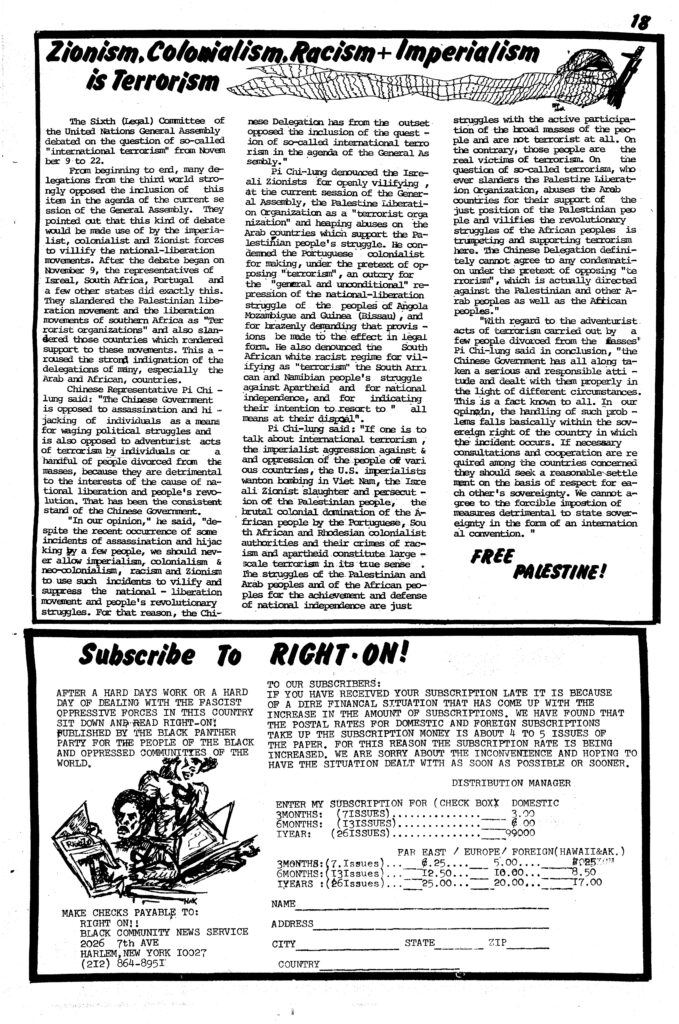
Yet, even between the obvious ideological and strategic challenges faced within the party, the editors of the Harlem publication still set out to be a Black community news service. They reported on the Panther 21 cases, as well as covered political prisoner campaigns and developments in the Puerto Rican liberation struggle. The West Coast Black Panther covered people’s survival programs being implemented in Mozambique, covered local political campaigns, and spoke directly about some of the strategies the party justified embarking on. Irrespective of what one identifies as the “correct side” of the split, it remains clear that both publications were directly invested in bringing revolutionary news reporting to their respective communities. The reporting occurring on both coasts for the BPP cemented a commitment that even if there were inter-party disagreements, the papers attempted to report on what was going on in the world as it pertained to revolutionary Black activity. Both papers demonstrate a clear commitment to the political organizing they were interested in stating the conditions of Black liberation struggle in their neighborhoods, across the country, and internationally. It is also important to note the significance of these publications to the BPP’s literacy programs. A significant justification for the publishing of the Black community news service was because it served as a resource for teaching people how to read. The paper opened new opportunities to develop one’s reading skills and also develop their political consciousness as they learned from the news. Less about the actual content being written, these papers were a further opportunity to engage with the masses. BPP members interfaced directly with those they served through their programs by distributing the paper and reporting on local issues. A genuine system of accountability could be produced because the publications were funded by local readers and the party, not by external sources. This meant that the newspapers were able to be for and by the masses in a real way, exemplifying the SNCC framework of what constituted a “revolutionary newspaper” and serving as an extension of a greater history to cover Black resistance movements.

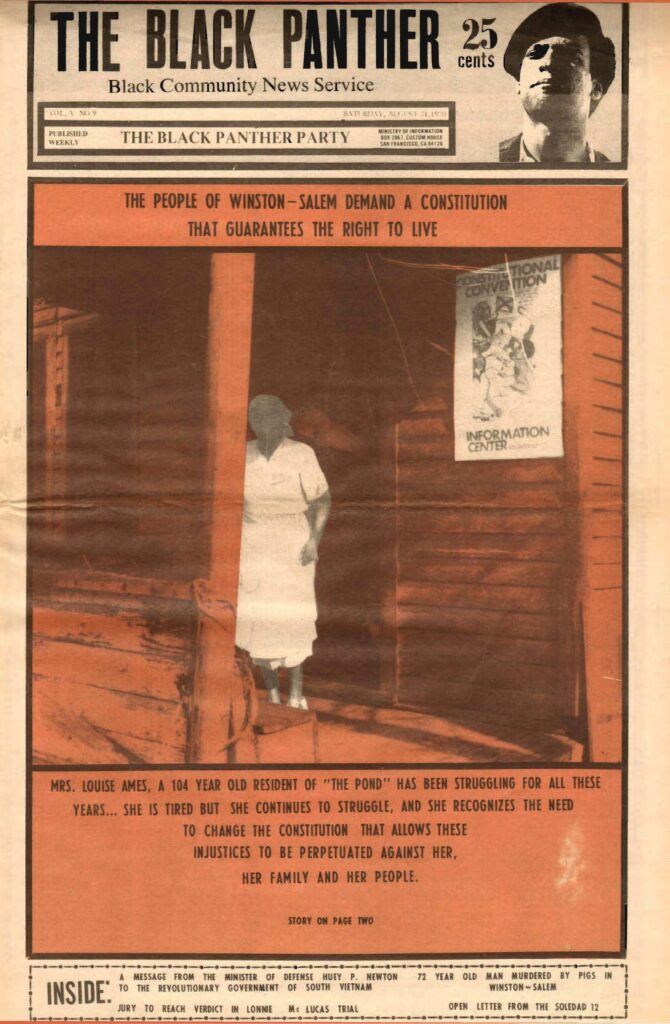
Revisiting old revolutionary publications and centering the frameworks outlined by SNCC and Dr. Shah can offer us tactics on how to effectively evaluate the news today. When reading about a current event, we should ask “Who is publishing the story?” and “What are the particular relationships the news outlet has to the masses and grassroots formations?” How does the journalist’s own politics impact or sway what is being written about or covered in their reporting? These are the types of questions that we can and should ask of the news that we consume to be better informed about ongoing people’s struggles everywhere. Publications of the movement serve as historical documents and as present-day guides for how to engage in the development of revolutionary news, whether in print or online. The challenge of this present moment is how we can reconcile the need for digital journalism while also recognizing the imperative need for journalism to be more personally relevant to its consumers. Particularly within the context of radical news, how then can different news ventures recreate that level of inter-personal relationship building like the journalism of the past? How can the person-to-person component of community journalism remain in the 21st century?
Perhaps printing physical copies again might be a way to address this problem. Additionally, papers like The Black Panther, Right On!, and The Movement were funded by their subscribers and by the masses. If news can and should be accountable to Black revolutionary political activity, then it would naturally need to be funded by those seeking to push forward such a politic. The question of how to sustain revolutionary journalism, as well as young journalists who wish to do this type of reporting, remains an important question for Black radical formations in the years to come to combat mainstream press narratives on their organizing. We can take away clear lessons from the Panthers to reignite a clearer commitment to movement journalism. From being hyperlocal in contextualizing international news, to developing better distribution of our news through our communities, there is a significant amount of work left to return to a movement press that is for the people. As cliche as it sounds, the masses need to trust the news and the reporters who are producing the journalism in their neighborhoods. These papers do not have to just inform the public; they should also be a space where local organizations can raise various issues in their communities and share the grassroots work that is being done to uplift the people. While it is more difficult to simply talk about things than act, the history of revolutionary publications can offer us optimistic strategies to reignite the press’s commitment to the movement. Returning to The Movement’s framework of revolutionary journalism can at least offer us some serious, concrete commitments publications need to maintain in our present moment.
-Noah

